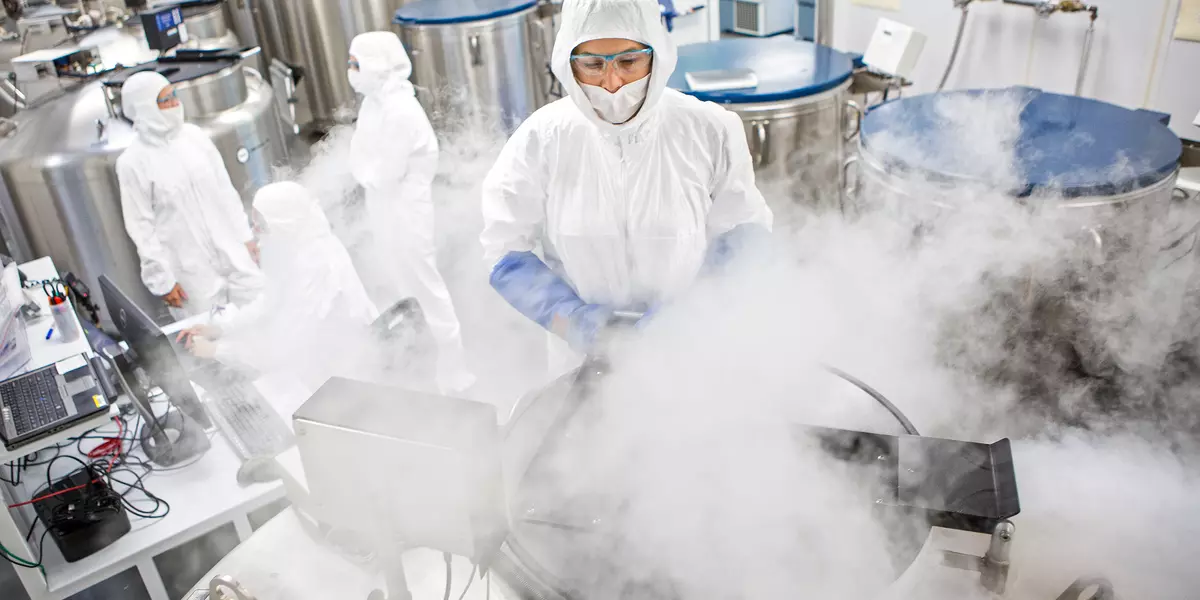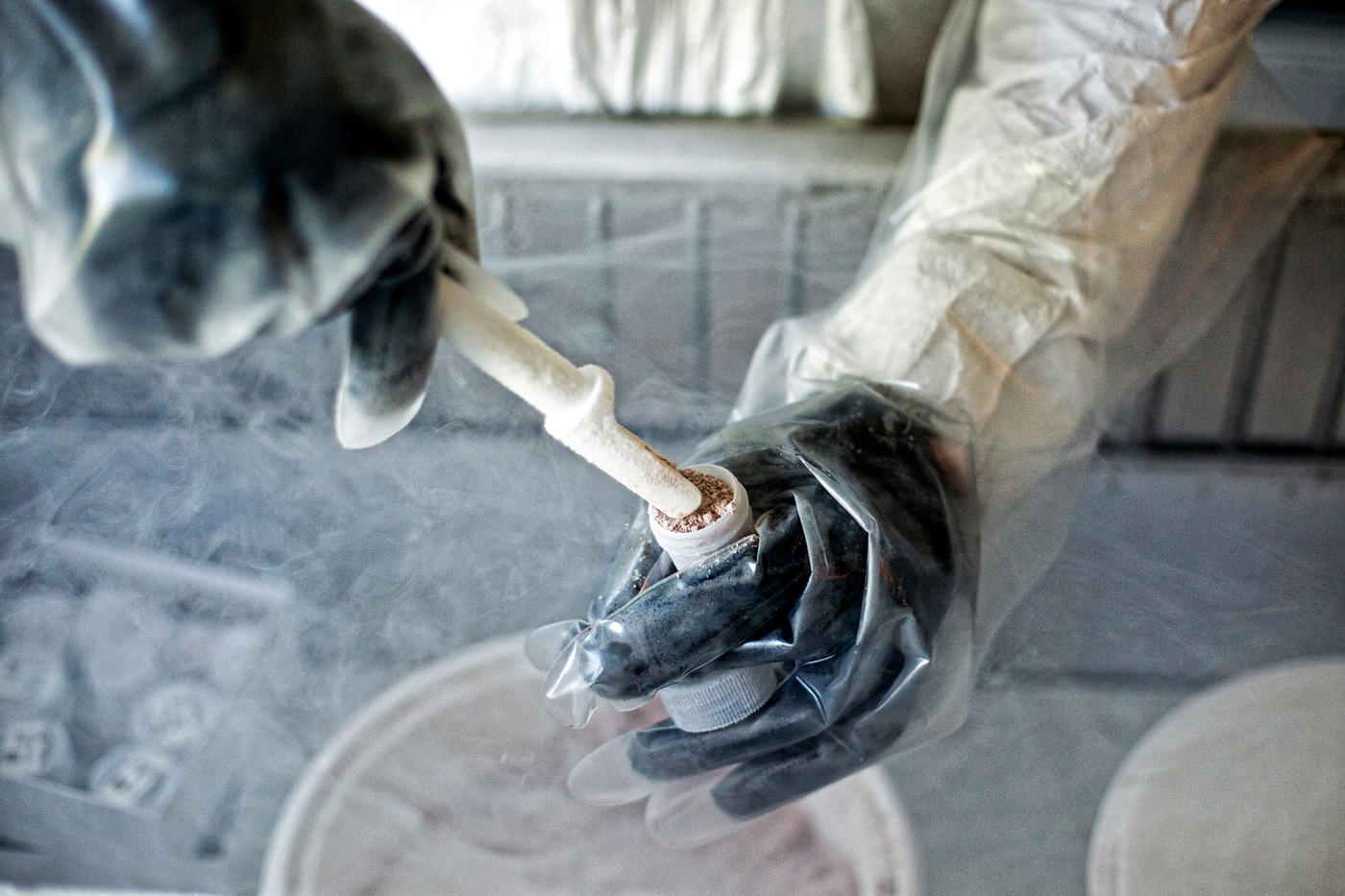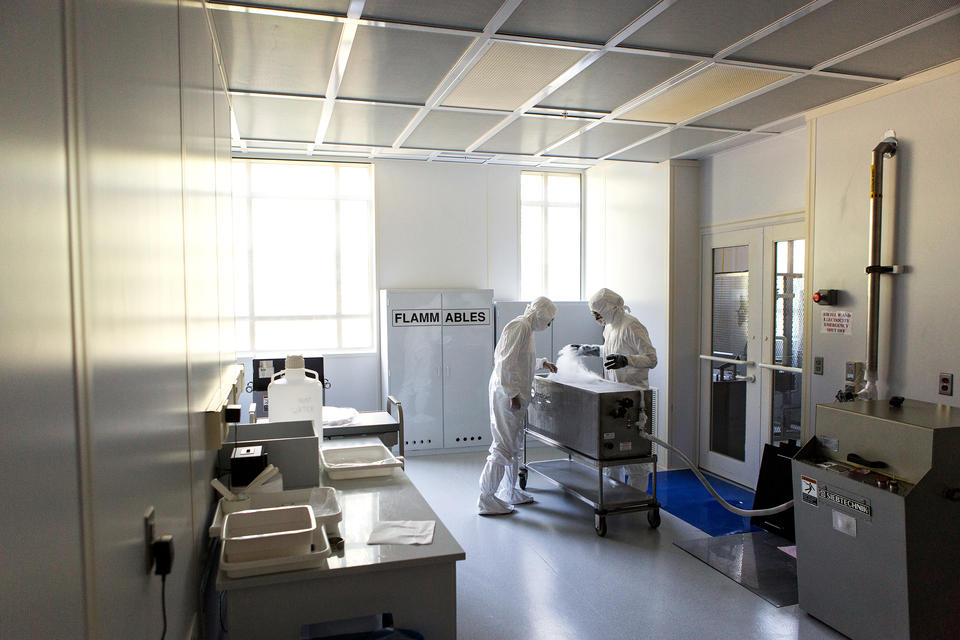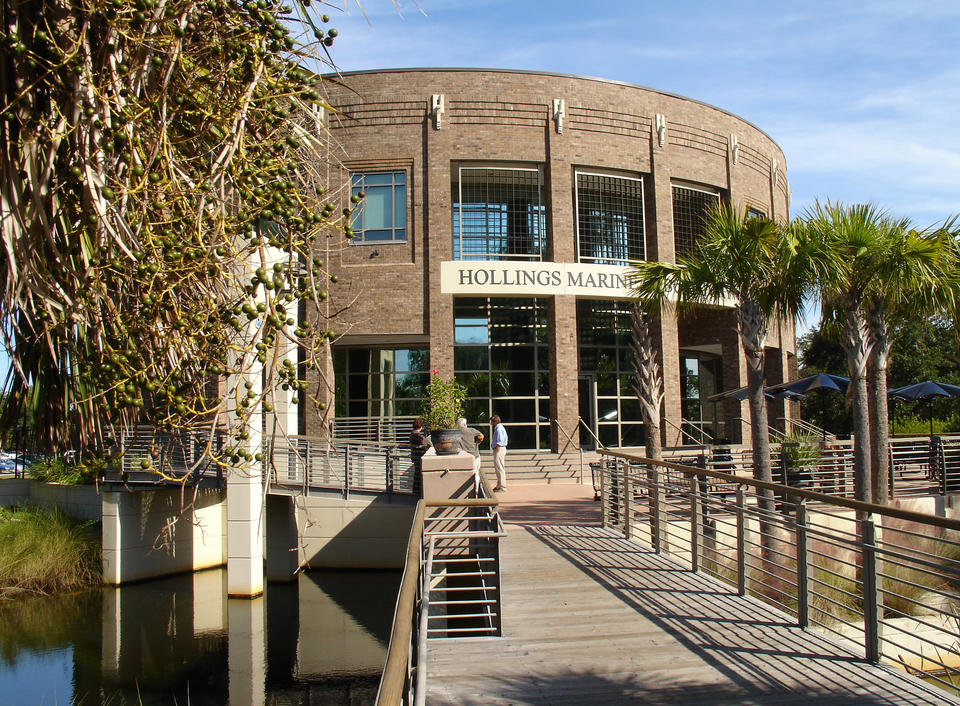
Giant metal tubs that look like brewers’ kegs use the power of liquid or vaporized nitrogen to maintain a steady, frozen state for important specimens.
Staying Chill, Even When Disaster Strikes
How NIST’s Cryogenic Teams Protect Invaluable Specimens
When most people prepare for a hurricane, they buy food and water. But when scientist Amanda Moors sees one of those big, red, pinwheel-shaped storms appear on the weather map, she buys liquid nitrogen.
Moors spends a lot of time thinking about failure. Not career failure or experiment failure, but equipment failure. And that’s where the liquid nitrogen comes in. Because if a hurricane hits her lab and there’s a power outage, a lot of the biological and environmental specimens archived there could be lost if she and her colleagues don’t adequately fill up the liquid nitrogen freezers and make sure the backup generators are ready.
“The best thing for us to do is to have a plan in place for evacuation and be prepared enough to know what’s going to happen and what to do to keep our samples safe and our freezers maintained,” says Moors, a scientist at the National Institute of Standards and Technology (NIST) who works at the Hollings Marine Laboratory in Charleston, South Carolina.
The specimens she and her colleagues maintain in the lab’s special specimen bank (often referred to by the more technical term “biorepository”) are incredibly rare, perhaps almost irreplaceable. There are bits of marine mammal and sea turtle tissue, mussels and oysters, and eggs from sea birds and peregrine falcons collected from several time points from the late 20th century through today. There are dolphin samples collected after the Deepwater Horizon Gulf of Mexico oil spill of 2010, and human liver tissue from EPA studies in the late 1970s and early 1980s.
Many of these specimens are already being actively used to investigate changes in pollutants, among other things. By studying what was in the blubber of a whale back in the 1980s, for example, and comparing it to what’s in the same kind of whale blubber now, researchers can assess if environmental changes across long time periods have impacted these creatures. In this way, the bank provides snapshots of what was happening under the ocean or inside humans during different periods of time. And as technology evolves and better analytical methods are developed, those snapshots of the past can be re-examined and used as reference points to reveal new insights.
Without a doubt, Moors loves the location of this place. When asked, she’ll tell you how the buildings are nestled near historic Fort Johnson, an important site in both the American Revolutionary War and the American Civil War. The Morris Island Lighthouse no longer blinks on and off, to warn boaters and ship captains about the proximity of James Island and its shallows and swamps, but still stands tall. Huge live oaks draped in Spanish moss are home to owls and ospreys, and azaleas bloom along the nearby roads each spring. “It’s a beautiful drive in to work each day,” she says with pride.
In many ways, the site is also ideal for conducting marine science investigations because of its access to the open ocean. It is convenient to get marine samples into the bank quickly and process them in a short period of time.
But that proximity is also one thing that makes the lab vulnerable, especially since this coastal city has been hit by a major storm system about once every two or three years. Being on a peninsula in a hurricane-prone location means the staff is often evacuated, not just from the building itself but from the city. Each time that happens, the people can head for higher ground, but the samples must stay behind.
Specimens arrive here from any number of collection points. In some cases, a specimen is gathered from a stranded animal on the beach, and the tissue is carefully prepared for freezing. In other cases, samples are the byproducts of a harvest from villages in the Arctic that depend upon subsistence food for nourishment. There are also samples voluntarily submitted by humans for previous environmental studies. Importantly, no animals were killed for the sake of filling the bank. Everything here was gathered under strict federal collection guidelines, permitting regulations and protocols involving species protection.
The processing of samples is done with extreme care. Once the specimens enter the building, they are brought to the first of three certified clean room laboratories, where all researchers who enter must don hooded, protective, particle-free suits over their street clothes; protective booties over their shoes; and safety goggles over their eyes so that they don’t contaminate the sample. Utmost care is also taken to ensure that no one working in the lab is exposed to potentially diseased or bacteria-laden tissues. HEPA filters and special HVAC systems keep dust particles out and make the air oxygen-rich, too. In this first room, any samples that haven’t already been put into the correct long-term storage container (i.e. plastic, polytetrafluoroethylene, glass) are addressed and labelled properly.
In an adjoining clean room, an assortment of long-term storage units awaits. There are 26 liquid nitrogen vapor-phase freezers with a temperature of -150 °C (-238 °F), six -80 °C (-112 °F) mechanical freezers, and two vapor-phase freezers that can be set to wide-range, user-defined temperatures anywhere between -50 °C (-58 °F) and -150 °C (-238 °F).
“People often ask if we get cold working in there,” Moors says. But the room itself is set to always be a steady 23.6 °C (74.5 °F). The samples are instead kept cold through cryogenic means; giant metal tubs that look like brewers’ kegs use the power of liquid or vaporized nitrogen to maintain a steady, frozen state for important specimens. When the tubs’ lids are lifted, white clouds of gas puff out dramatically.
The samples could be damaged if any part of the system goes down in the lab building and temperatures in the storage areas change. Consistent supplies of nitrogen are a must to keep the system going, and Moors says they’ve learned over the years that as soon as they know the city is in the path of a storm they should immediately check supplies and consider ordering a refill. Delivery can be tricky to schedule. Although fighting evacuation traffic to get to the lab with a tank or two is not always easy for suppliers, the lab likes to plan arrival so that they can get as much time as possible on the back end of a storm, in case there’s a loss of power. The team also works with their own facility manager to ensure that the backup generators are ready to kick on and run for as long as needed.

Preparing a sample for long term cryogenic storage at NIST Charleston demands two sets of gloves and a lot of patience.
Moors and other staff members must remain tethered to their smartphones even when off-campus, much like medical doctors on call. If the conditions in the clean rooms or storage freezers fluctuate outside of alarm set points, the system calls a preselected phone list until someone answers, prompting them with a recording that asks: What do you want to do about this problem?
If possible, an employee must then come to the facility to see what is causing the trouble. This is true during long holiday weekends and even during those times that the government has shut down. And sometimes, even on bright sunny days with good weather when the system senses something is not working up to par.
“It has happened at every hour of the day you can imagine,” Moors says. “New Year’s Eve you might get a phone call. 2 a.m. 4 a.m. Anytime.”
When a hurricane sends them fleeing, they hope their backup system will perform as designed and stay cool even if the power grid goes down. The entire system is designed to keep specimens safe for weeks, and so far, it has performed as designed.
The field of emergency planning really came alive after Hurricane Katrina, says Zisis Kozlakidis, president of the International Society for Biological and Environmental Repositories (ISBER). “The level of devastation was so significant. Before that, even in the best practices there weren’t specific sections devoted to it. There are now.”
Kozlakidis and ISBER highly recommend that anyone running a repository develop a backup plan like the one that Moors and the team at the Hollings Marine Lab have implemented. No matter how big or small and no matter what the collection methods might have been, the chances of power outage or other kinds of failure are very big.
“We realize that as the biobanks grow bigger, the investments in getting the samples becomes a lot larger so there needs to be a concerted effort to protect them.”
Technically, there is no definition of what makes a repository, although ISBER soon hopes to have one. For five years, members of ISBER and other organizations have been hard at work on an ISO standard that will help to formalize the term and guide people with appropriate best practices for running such a facility. The resulting ISBER Best Practices are now freely available online to the benefit of the entire scientific community. Gathering together professionals such as Moors for discussions and to develop best practices has been key. This past May, she led a workshop at the group’s annual meeting on collection methods, for example.
One thing that most in the field have agreed upon is that a biorepository need not be an ultracold storage unit. A dry cabinet filled with seeds can qualify as one, as can a regular freezer with just a few samples in vacuum bags, depending upon research goals. The difference between plain storage facilities and repositories, Kozlakidis explains, is the collection of data related to the samples. And while there is no official registration, count or census regarding repositories, they do seem to be growing in number as more and more people need to work with organic tissues.
“Precision medicine has put a lot of work on our plates,” he says.
Although in tight budget times it may be tempting to cut corners on something so seemingly tangential to the actual research as an emergency plan or backup generators, Kozlakidis says he often makes the argument that it is cheaper to prepare for a crisis than it is to replace an entire set of samples or start an entire study over from the beginning after a loss.

Scientists working in a "clean room" at the NIST lab in Charleston carefully prepare specimens for long-term cryogenic storage.
Despite an increase in big storms, he’s gratified to have seen a decrease in incidents of catastrophic specimen loss, something he thinks is a direct result of better planning.
Even so, the most experienced people in the field find that they need to keep fine-tuning the process. In 2016 when Hurricane Matthew lashed the South Carolina coast, NIST had not yet finished upgrading the monitoring software associated with its storage areas, causing problems in monitoring capacity. As the fierce storm landed and the staff evacuated, many agonized over not being able to check in on the status of the samples left behind in real time. As it turned out, the liquid nitrogen tanks did their job and were fine, even if no one could follow along remotely via smart phone. The temperatures did not fluctuate.
But two lessons were learned from that experience, says Steve Choquette, who runs NIST’s large standard reference material (SRM) program: Equipment upgrades should be done on a regular basis, and keeping all the NIST samples in one location can be risky.
Choquette is based at NIST’s Gaithersburg, Maryland, campus, and understands all too well how important storage equipment is for biological and chemical samples. “We protect literally millions of dollars’ worth of SRMs, so we take it seriously.”
“You’ve got people with years of their lives invested in experiments and they depend on those samples,” says Choquette. “The thought of losing them—it makes me sick.”
In 2017, Choquette worked closely with Rebecca Pugh at NIST Charleston to develop what is known as a split—whereupon some important samples that had been portioned-off and designated for long-term archival storage were carefully transferred from Charleston to Gaithersburg.
The ‘A’ subsamples were always stored in separate freezers from their duplicate representatives in the ‘B’ subsample group, Pugh notes.
“But a true best practice is to split the samples and store them in two geographic locations,” she explains. “Locating the space and identical storage equipment in Gaithersburg gave us peace of mind, too.”
An independent cryogenics company was then hired to pick up two liquid nitrogen freezers from the Gaithersburg SRM warehouse and transfer them by truck to Charleston, where staff carefully moved the “B group” samples into the freezers for transfer back to Maryland. The company’s moving team monitored the freezer temperatures and nitrogen fill levels during the trip to make sure they stayed stable.
“We realized we don’t want to put all of our eggs in one basket,” says Moors.
The next step will be to develop more extensive backup plans for the SRM storage in Gaithersburg. Although to date no emergency has ever made it impossible to get on campus to check on the ultra-important storage facility in a timely manner, needs are changing and demand is growing as new SRMs make it to market.
“As more biologic [pharmaceuticals] come onto the scene,” Choquette says, “we’ll need more space and a more robust electrical backup plan.”

NIST's Hollings Marine Laboratory in Charleston, SC.
He also notes that the design of the storage space is important. At NIST and most large labs, the drawers used for storage are like giant, room-sized thermoses, and are designed to keep things safe and stable for over two full weeks, even without power.
Moors is also quick to point out that many of the things you can do to protect biobank specimens involve no outlay of extra money. They simply involve making a thoughtful plan with fellow scientists, and sticking to it.
The NIST Charleston team, for example, conducts a mandatory meeting each year at the start of hurricane season to review their emergency preparedness plan and what they all will do when a storm does arrive.
They also realized a while back that fatigue could be an issue for those in charge of babysitting the facility each and every week. Nonchalance could take over, and the temptation to ignore a buzzing alarm in the wee hours of the night could be overpowering. As such, they make sure to rotate staff responsibilities regarding the alarm phone tree list on a frequent basis, meaning no one gets burnout, and no one feels uniquely burdened.
Moors and her team were pleased when a freak storm this past winter proved that their plan was working. It is rare to ever get snow at all in South Carolina, so it was a surprise to wake up one morning and find several inches of heavy white stuff blanketing the seaside enclave, and many large branches from those beautiful live oaks falling on power lines and blocking roads. Driving was a challenge, and it took several days to get everyone back to the lab for work.
“Our specimens were just fine, though,” says Moors.

